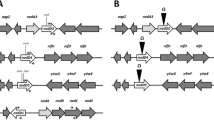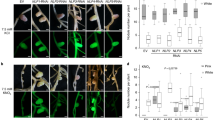Abstract
The expression of the nodulation genes nodABC of Rhizobium meliloti, which determine early response functions to plant host signals, is regulated by the level of ammonia, the primary product of symbiotic nitrogen fixation. We show that the pathway that links the ammonia-induced signal to the transcriptional control of the nodABC genes involves at least two regulatory levels. The fluctuating nitrogen level is sensed and the signal is mediated by the members of the general nitrogen regulatory (ntr) system, then transmitted to the syrM-nodD3 genes representing the nod-specific level of ammonia regulation. At low ammonia concentration, the activator protein NtrC exerts its effect via nodD3. In conditions of nitrogen excess ntrR, involved in the repression of nod genes, may function in coordination with the syrM gene. Finally, the NodD3 protein may relay the nitrogen status signal to the transcriptional control of the nodABC genes.
Similar content being viewed by others
References
Baev N, Amar M, Defez R, Iaccarino M (1992) The expression of the nodD and nodABC genes of Rhizobium leguminosarum is not regulated in response to combined nitrogen. FEMS Microbiol Lett 97:205–208
Beringer JE, Beynon J, Buchanan-Wollaston AV, Johnston AWB (1978) Transfer of drug-resistance transposon Tn5 to Rhizobium. Nature 276:633–634
Boyer HW, Rouland-Dussoix D (1969) A complementation analysis of the restriction and modification of DNA in Escherichia coli. J Mol Biol 41:459–472
de Bruijn FJ, Rossbach S, Schneider M, Ratet P, Messmer S, Szeto WW, Ausubel FM, Schell J (1989) Rhizobium meliloti 1021 has three diferentially regulated loci involved in glutamine biosynthesis, none of which is essential for symbiotic nitrogen fixation. J Bacteriol 171:1673–1682
de Bruijn FJ, Hilgert U, Stigter J, Schneider M, Meyer AH, Klosse U, Pawlowski K (1990) Regulation of nitrogen fixation and assimilation genes in the free-living versus symbiotic state. In: Gresshoff PM, Roth AB, Stacey G, Newton AW (eds) Nitrogen fixation: achievements and objectives. Chapman and Hall, New York London, pp 33–44
Buck M (1986) Deletion analysis of the Klebsiella pneumomae nitrogenase promoter: importance of spacing between conserved sequences around positions −12 and − 24 for activation by the nifA and ntrC (glnG) products. J Bacteriol 166:545–551
Carroll BJ, Mathews A (1990) Nitrate inhibition of nodulation in legumes. In: Gresshoff PM (ed) Molecular biology of symbiotic nitrogen fixation. CRC Press, Boca Raton, Florida, pp 159–180
Ditta G, Stanfield S, Corbin D, Helinski DR (1980) Broad hostrange DNA cloning system for gram-negative bacteria: construction of a gene bank of Rhizobium meliloti. Proc Natl Acad Sci USA 77:7347–7351
Dusha I, Bakos A, Kondorosi A, de Bruijn FJ, Schell J (1989) The Rhizobium meliloti early nodulation genes (nodABC) are nitrogen-regulated: isolation of a mutant strain with efficient nodulation capacity on alfalfa in the presence of ammonium. Mol Gen Genet 219:89–96
Ferro-Luzzi Ames G, Nikaido K (1985) Nitrogen regulation in Salmonella typhimurium. Identification of an ntrC protein-binding site and definition of a consensus binding sequence. EMBO J 4:539–547
Fisher RF, Long SR (1989) DNA footprint analysis of the transcriptional activator proteins NodD1 and NodD3 on inducible nod gene promoters. J Bacteriol 171:5492–5502
Fisher RF, Egelhoff TT, Mulligan JT, Long SR (1988) Specific binding of proteins from Rhizobium meliloti cell-free extracts containing NodD to DNA sequences upstream of inducible nodulation genes. Genes Dev 2:282–293
Gicquel-Sanzey B, Cossart P (1982) Homologies between different procaryotic DNA-binding regulatory proteins and between their sites of action. EMBO J 5:591–595
Göttfert M, Horvath B, Kondorosi E, Putnoky P, Rodriguez-Quinones F, Kondorosi A (1986) At least two nodD genes are necessary for efficient nodulation of alfalfa by Rhizobium meliloti. J Mol Biol 191:411–420
Gussin GN, Ronson CW, Ausubel FM (1986) Regulation of nitrogen fixation genes. Annu Rev Genet 20:567–591
Györgypal Z, Iyer N, Kondorosi A (1988) Three regulatory nodD alleles of diverged flavonoid specificity are involved in host-dependent nodulation by Rhizobium meliloti. Mol Gen Genet 212:85–92
Hawkes T, Merrick M, Dixon RA (1985) Interaction of purified NtrC protein with nitrogen regulated promoters from Klebsiella pneumoniae. Mol Gen Genet 201:492–498
Honma MA, Ausubel FM (1987) Rhizobium meliloti has three functional copies of the nodD symbiotic regulatory gene. Proc Natl Acad Sci USA 84:8558–8562
Honma MA, Asomaning M, Ausubel FM (1990) Rhizobium meliloti nodD genes mediate host-specific activation of nodABC. J Bacteriol 172:901–911
Kondorosi E, Banfalvi Z, Kondorosi A (1984) Physical and genetic analysis of a symbiotic region of Rhizobium meliloti: identification of nodulation genes. Mol Gen Genet 193:445–452
Kondorosi E, Gyuris J, Schmidt J, John M, Duda E, Hoffmann B, Schell J, Kondorosi A (1989) Positive and negative control of nod gene expression in Rhizobium meliloti is required for optimal nodulation. EMBO J 8:1331–1340
Kondorosi E, Buire M, Cren M, Iyer N, Hoffmann B, Kondorosi A (1991) Involvement of the syrM and nodD3 genes of Rhizobium meliloti in nod gene activation and in optimal nodulation of the plant host. Mol Microbiol 5:3035–3048
Maillet F, Debelle F, Denarie J (1990) Role of the nodD and syrM genes in the activation of the regulatory gene nodD3, and of the common and host-specific nod genes of Rhizobium meliloti. Mol Microbiol 4:1975–1984
Maniatis T, Fritsch EF, Sambrook J (1982) Molecular cloning: a laboratory manual. Cold Spring Harbor Laboratory Press, Cold Spring Harbor, New York
Mulligan JT, Long SR (1985) Induction of Rhizobium meliloti nodC expression by plant exudate requires nodD. Proc Natl Acad Sci USA 82:6609–6613
Mulligan JT, Long SR (1989) A family of activator genes regulates expression of Rhizobium meliloti nodulation genes. Genetics 122:7–18
Peters NK, Frost JW, Long SR (1986) A plant flavone luteolin induces expression of Rhizobium meliloti nodulation genes. Science 233:977–980
Reitzer LJ, Magasanik B (1986) Transcription of glnA in E. coli is stimulated by activator bound to sites far from the promoter. Cell 45:785–792
Ronson CW, Nixon BT, Albright LM, Ausubel FM (1987) Rhizobium meliloti ntrA (rpoN) gene is required for diverse metabolic functions. J Bacteriol 169:2424–2431
Rostas K, Kondorosi E, Horvath B, Simoncsits A, Kondorosi A (1986) Conservation of extended promoter regions of nodulation genes in Rhizobium. Proc Natl Acad Sci USA 83:1757–1761
Rushing BG, Yelton MM, Long SR (1991) Genetic and physical analysis of the nodD3 region of Rhizobium meliloti. Nucleic Acids Res 19:921–927
Ruvkun GB, Ausubel FM (1981) A general method for site-directed mutagenesis in procaryotes. Nature 289:85–88
Simon R, Priefer U, Pühler A (1983) Vector plasmids for in vivo and in vitro manipulation of gram-negative bacteria. In: Pühler A (ed) Molecular genetics of the bacteria-plant interaction. Springer-Verlag, Berlin, pp 98–106
Stanley J, van Slooten J, Dowling DN, Finan T, Broughton WJ (1989) Molecular cloning of the ntrA gene of the broad hostrange Rhizobium sp. NGR234, and phenotypes of a site-directed mutant. Mol Gen Genet 217:528–532
Szeto WW, Nixon BT, Ronson CW, Ausubel FM (1987) Identification and characterization of the Rhizobium meliloti ntrC gene: R. meliloti has separate regulatory pathways for activation of nitrogen fixation genes in free-living and symbiotic cells. J Bacteriol 169:1423–1432
Wang S-P, Stacey G (1990) Ammonia regulation of nod genes in Bradyrhizobium japonicum. Mol Gen Genet 223:329–331
Yanisch-Perron C, Vieira J, Messing J (1985) Improved M13 phage cloning vectors and host strains: nucleotide sequences of the M13mpl8 and pUC19 vectors. Gene 33:103–119
Yu G-Q, Zhu J-B, Deng X-B, Shen S-J (1993) Evidence that the nodulation regulatory gene nodD3 of Rhizobium meliloti is transcribed from two separate promoters. Science in China 36:225–236
Author information
Authors and Affiliations
Additional information
Communicated by J. Schell
Rights and permissions
About this article
Cite this article
Dusha, I., Kondorosi, A. Genes at different regulatory levels are required for the ammonia control of nodulation in Rhizobium meliloti . Molec. Gen. Genet. 240, 435–444 (1993). https://doi.org/10.1007/BF00280398
Received:
Accepted:
Issue Date:
DOI: https://doi.org/10.1007/BF00280398




